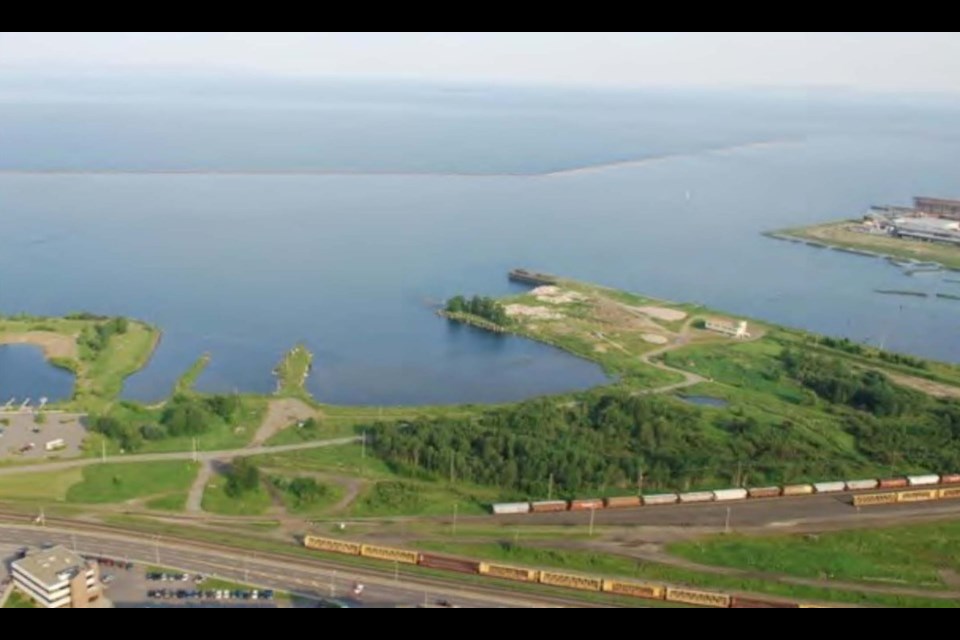A study could help determine next steps in the development of Thunder Bay's waterfront at Pool 6, considering possibilities including housing and hotels along with a proposed science centre.
The Thunder Bay Community Economic Development Commission (CEDC) is hiring a consultant to conduct a “best use” study of the city-owned Pool 6 lands for up to $100,000.
CEO Jamie Taylor describes the property as a “huge opportunity” for the city and a logical next step in waterfront development.
“I don’t think anybody will argue, Prince Arthur’s Landing is a beautiful space, and it really transformed the city … in terms of the impact to the downtown core,” she said in an interview. “This could be the next phase, and the sky’s the limit.”
The lands known as Pool 6, bearing the name of the grain elevator that once stood on the site, sit directly south of Prince Arthur’s landing and the future site of the Thunder Bay Art Gallery.
The property encompasses 12.2 hectares, extending west from a dock that welcomes the growing number of cruise ships visiting the city.
The CEDC study will examine how the city could maximize economic development on the property, including building the city’s tax base and supporting businesses.
That’s likely best accomplished with a “mixed-use” model for the lands that could incorporate housing or accommodations alongside recreation and tourism opportunities, Taylor said.
However, she added the CEDC isn’t going into the process with specific projects or outcomes in mind.
“We don’t have any preconceived notions in terms of what exactly this development would look like, and that’s the purpose of getting this outside view,” she said.
“If you look at what’s already happened down at the waterfront, we’d expect there would be some opportunities that complement what’s already down there, whether or not that includes further hotel development or even further residential development.”
The study’s terms of reference say it will determine “the use that will result in highest value for City of Thunder Bay from an economic and tourism lens,” but also speak to preserving the area’s industrial, Indigenous, and natural heritage.
The final report will include at least three development scenarios, including estimated infrastructure costs and tax benefits, and a summary of land use restrictions. The study assumes the city will not sell the lands, but could lease them.
Some work related to the study, like drilling for an environmental assessment, has already begun.
The report will help inform the “phase 2 waterfront master plan” the city is currently working on, which will set goals for development beyond Prince Arthur’s landing.
Want to read more stories about business in the North? Subscribe to our newsletter.
Taylor said there’s already been plenty of interest in Pool 6, with cruise shipping booming and Science North selecting the site as its preferred location for a proposed Thunder Bay science centre.
The study will look at existing uses of the property, which include a municipal administrative building and, notably, the Lakehead Transportation Museum, which has been leasing a parcel of the Pool 6 lands since 2017.
The study won’t assume the two facilities remain in place in the long run, with its terms of reference explicitly stating the city building “can be relocated” but not directly addressing the museum’s status.
“It’s kind of a blank slate,” Taylor said. “Definitely we have to take a look at what the current assets are that are down there, and what are the current uses.”
“But [the study] is going to provide, what are the other opportunities as well.”
Wally Peterson, vice-president of the Lakehead Transportation Museum Society, expressed confidence the museum is already helping to meet the CEDC’s goals for the land by attracting tourism and preserving its cultural and industrial heritage.
“I fully expect that they’re going to say, where you are and what you’re doing is one of the best uses of this area,” he said.
“The fact that the scope of work for the project involves determining the best economic and tourism effect that could occur on that site for the city, keeping the … industrial and natural heritage of Thunder Bay in sight — that’s what we’re doing.”
The volunteer-run museum hosts the Alexander Henry museum ship and other artifacts including two brill buses — all built in Thunder Bay — on a small patch of the Pool 6 site adjacent to the cruise ship dock.
The museum’s presence “limits the city’s expenses to improve that area, because everything down there, we’ve funded,” Peterson added.
The museum, which has been the only public attraction in the former industrial lands of Pool 6, welcomes the prospect of further development.
“Anything that brings people down to where we are is of value to us,” Peterson said.
Still, he acknowledged the study opens the possibility of other uses for the museum site. He noted the group’s lease on the Pool 6 lands expired late last year, and the city hasn't yet moved forward with a renewal.
“Of course, you always have trepidation when you’re dealing with space that you’re renting, in case terms change and you’re not going to be there,” he said. “Once they do the study and all of the evaluation, anything is possible.”
The Pool 6 site also includes a habitat pond built in 2013 as part of a habitat compensation agreement between the city and federal government.
Bids to perform the best use study were due on Thursday. The CEDC hopes to award the contract by the end of the month, with a final report expected in June.
The CEDC will share results of the study publicly as well as with the city, though it will not include opportunities for public input. Taylor said that’s something that will come with any specific development plans in the future.
— TBNewswatch




